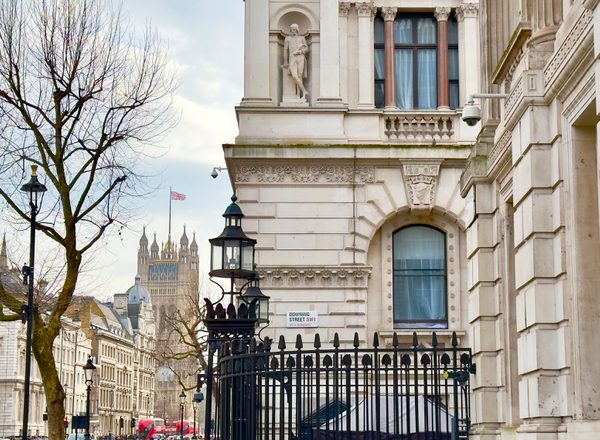
Bookkeepers or changemakers? Understanding the chancellor’s choices ahead of the budget
Article
The Labour party won the last election by ‘de-risking’ a Labour vote on key economic policy agendas. At the heart of this was a strategy to regain Labour’s reputation for economic competence.
It sought to achieve this by making a number of ‘stability promises’: committing to the Conservatives’ fiscal rule which ensures that debt as a proportion of GDP is falling in the fifth year of a forecast period, and promising not to raise income tax, national insurance or VAT - as well as making promises to business on corporation tax.
At the same time the Labour party won a mandate for change and has committed to delivering a ‘decade of national renewal’. These ‘change promises’ have been defined in Labour’s five missions as ambitious progress on economic growth and higher wages, decarbonisation, better health, more opportunity and lower crime. These speak to a desire across the public for politics to address the deep challenges that face our society.
In opposition, Labour argued that both of these promises could be met through ‘growth and reform’. There is some logic to this. The UK’s growth rate has been poor. Higher growth would bring in higher tax revenues without having to raise tax rates. Likewise, reform in our economy and in our public services can both unlock economic growth and public sector productivity improvements (therefore reducing the need for additional public spending).
However, there are real tensions between Labour’s ‘stability’ and ‘change’ promises. Firstly, the benefits of higher growth and greater public sector productivity are likely to take time to materialise but will require upfront investment now to be unlocked. Moreover, in some cases, even if the government can maximise the contribution of reform to economic growth and public sector productivity there will still be a need for higher investment and spending.
There are real tensions between Labour’s ‘stability’ and ‘change’ promises
This implies that the new government may face an unpalatable political choice. Does it prioritise stability, keeping to the letter of promises on taxes, borrowing and spending, but risk failing to deliver improved living standards and public services? Or, does it focus on change, moving to free up more resources - by reforming fiscal rules and finding additional tax revenue - in order to deliver improved living standards and public services?
IPPR believes that change is the right choice. Our research on public services, the environmental challenge and economic growth has demonstrated the need for 'a decade of national renewal', the opportunity to transform the UK through ambitious policy, and the need for investment and spending to achieve this. But a democratically-elected government must answer to voters, so a convincing case for this change must be founded on a clear understanding of public attitudes towards the choices facing government. This is the understanding that we at IPPR and Persuasion UK set out to achieve using focus groups, polling and messaging testing (for a full methodology, see slide deck).
We found that Labour government which is perceived to have delivered on its ‘tax, borrowing and spending promises’ but failed to deliver change in public services will be judged a failure and punished by voters. This is especially crucial for voters who switched to Labour in 2024 (figure 1). Among general election 2024 switchers to Labour, a scenario in which government debt and deficits have been reduced but NHS waiting lists are unchanged leads to a government approval rating of -12, a fall of 28 percentage points from current approval ratings with switchers.
The public prefer the government to borrow more, find additional tax revenues (within their rules) and deliver on change
Instead, the public prefer the government to borrow more, find additional tax revenues (within their rules) and deliver on change - with a particular focus on public services. A scenario where waiting lists are halved – even at the expense of debt or taxes rising – leads to a +31 approval rating with this group, 15 percentage points higher than now. Similar results are found seen for Conservative to Labour switchers.
Figure 1: Voters which switched to Labour at the election – including Conservative to Labour switchers - prioritise Labour’s ‘change’ over ‘stability’ promises
Impact of outcome/trade off on government approval rating
IPPR has mapped out a range of policy options for both borrowing and tax that stay within the spirit of Labour’s ‘stability’ promises but would allow them to deliver real change at the budget.
- Borrowing: UK public investment has been below the G7 for all of the last three decades, and it is set to fall further, depressing growth and holding back public services. One of the key factors holding us back is our fiscal rules. The rules inherited from the previous government do not even work on their own terms (eg promoting fiscal sustainability). This is because investment can have significant future returns and can thus be paid for by borrowing. Options for reform to address this include a change from targeting ‘net debt’ falling in year five, to ‘Public Sector Net Financial Liabilities’ (PSNFL) falling or public sector net worth (PSNW) increasing in year five of the forecast. These indicators would better reflect the productive assets created through investment. Their use would increase ‘headroom’ for borrowing to invest by more than £50 billion.
- Taxation: The UK has average levels of taxation as a per cent of GDP compared to other developed OECD economies. Whilst reform of the debt rule can create additional ‘headroom’ for borrowing and investment, increasing taxation will be important to cover day-to-day spending on public services and debt interest within the government’s current spending rule. Even within Labour’s manifesto commitments not to raise rates of income tax, national insurance, corporation tax or VAT, there are still ways of raising tax revenue fairly from those most able to bear it. IPPR have sought to identify these revenue raisers (figure 2) - though given the scale of the addition resources needed for Labour to avoid another round of austerity even these additional revenues would leave the Chancellor facing difficult choices about spending.
Figure 2: Potential tax increases that sit within Labour’s ‘tax rules’
Estimated revenue raised £bn
Tax change | Revenue projection in 2025/6 | Source |
Equalising capital gains tax with income tax | £14bn | CenTax |
Cap the level of tax relief on pension contributions at 30%, limiting tax breaks on savings received by higher earners | Not available, long-run £3bn | IFS |
Introduce national insurance contribution (NIC) tax on investment income | £8bn | CAGE |
Ending AIM shares exemption from inheritance tax | £1.1bn | IFS |
Capping agricultural and business relief in IHT at £500,000 | £1.4bn | IFS |
Taxing share buybacks | £0.1bn – £2bn | IPPR |
Tightening the intermediary exemption on stamp duty taxes | Around £1.5-£2.4bn per year | Intelligence Capital |
A new levy on the profits of tobacco companies | £0.7bn | ASH |
End the freeze on alcohol duty, increasing tax on alcohol by 6.5% | £0.2bn | IPPR |
A new levy on the profits of gambling companies | £2.9bn | IPPR |
End the freeze on fuel duty, increasing tax on petrol | £2.5bn | OBR |
Increasing national insurance tax by 2%, reversing the previous government’s cut | £9.3bn | OBR |
Source: IPPR analysis and other sources
The majority of these measures are popular with voters. Across all these tax policies only increasing fuel duty has more people against than in favour - with large majorities in favour of reforms to stamp duty and to capital gains tax. This is true for Conservative to Labour switchers (see figure 3) as well as all voters. The same is true for changes to the fiscal rules in order to increase public investment (see figure 4) with net support sitting between 46 per cent and 85 per cent depending on the framing and the group asked (eg all voters vs Conservative to Labour switchers). Those taxes which more directly impact on the cost of living for individuals - for example, fuel duty or alcohol duty - are unsurprisingly less popular.
Figure 3: More Conservative to Labour switchers support most potential tax changes than oppose
Responses to “To what extent do you personally support or oppose the Labour government introducing each of the following economic policies?”
Figure 4: A majority of voters would support Labour changing its fiscal rules to create space for more borrowing
Responses to “to what extent, if at all, would you support or oppose the Labour government changing its fiscal plans to allow for more borrowing for…” Net support (all those in favour minus all those against)
These policies are most popular when they are framed as part of a solution to Britain’s crumbling infrastructure and public services. On ‘borrow to invest’, changes to fiscal rules are most popular when linked to rebuilding infrastructure and public services (see figure 5). On taxation of income from wealth, the most popular framing is around fairness, with revenue raising for spending on public services also popular (see figure 6). Well known counter-arguments - including “this is the same old Labour’ - do not cut through and are outperformed by progressive arguments for these changes.
Figure 5: Arguments which link additional borrowing to infrastructure or public services are most popular
Responses to “Some people have argued that the Labour government should change its fiscal plans to allow greater government borrowing. Others have argued against changing plans in this way. Which argument do you personally find most convincing?”
Figure 6: Arguments which foreground fairness make the best case for taxes on income from wealth
Responses to “Some people have argued for a range of new policies which tax earnings gained from wealth. Others have argued against raising taxes in this way. Which arguments do you personally find more convincing?”
The popularity of these measures is resilient to well-known attacks. All potential frames for justifying the government moving on tax increases and changes to the fiscal rules are resilient to common attack lines. However, the argument that these changes are needed to “clean up the last government’s mess” is the least convincing (see figure 7). Instead, voters respond best to arguments that relate these changes to fixing public services or, in the case of taxation, fairness.
Figure 7: All groups find potential Labour messaging for action on taxes and borrowing more convincing than possible Conservative and business counter arguments
Responses to “You’ve just seen a hypothetical Labour argument for raising taxes on the wealthiest and allowing for more government borrowing to invest in infrastructure. You’ve also seen a political/business advert against this. Which argument did you find more convincing?”
The dire state of our public realm - and the degree of support for the changes needed to tackle these issues - should give the government the confidence to be bold at the budget, and choose change. As IPPR has argued in recent months, the government should shift both fiscal rules and raise additional revenue, with a focus on taxes on those with the broadest shoulders. It should target this additional fiscal space at getting investment up to drive growth and on preventing a second round of austerity in public services. It should also use this moment to shift the narrative to a more forward looking one of rebuilding the nation and fixing public services. Our research shows that this is what voters want: they will reward a government that delivers it, and punish one which doesn’t. Now is the time to deliver a 'decade of national renewal'.


